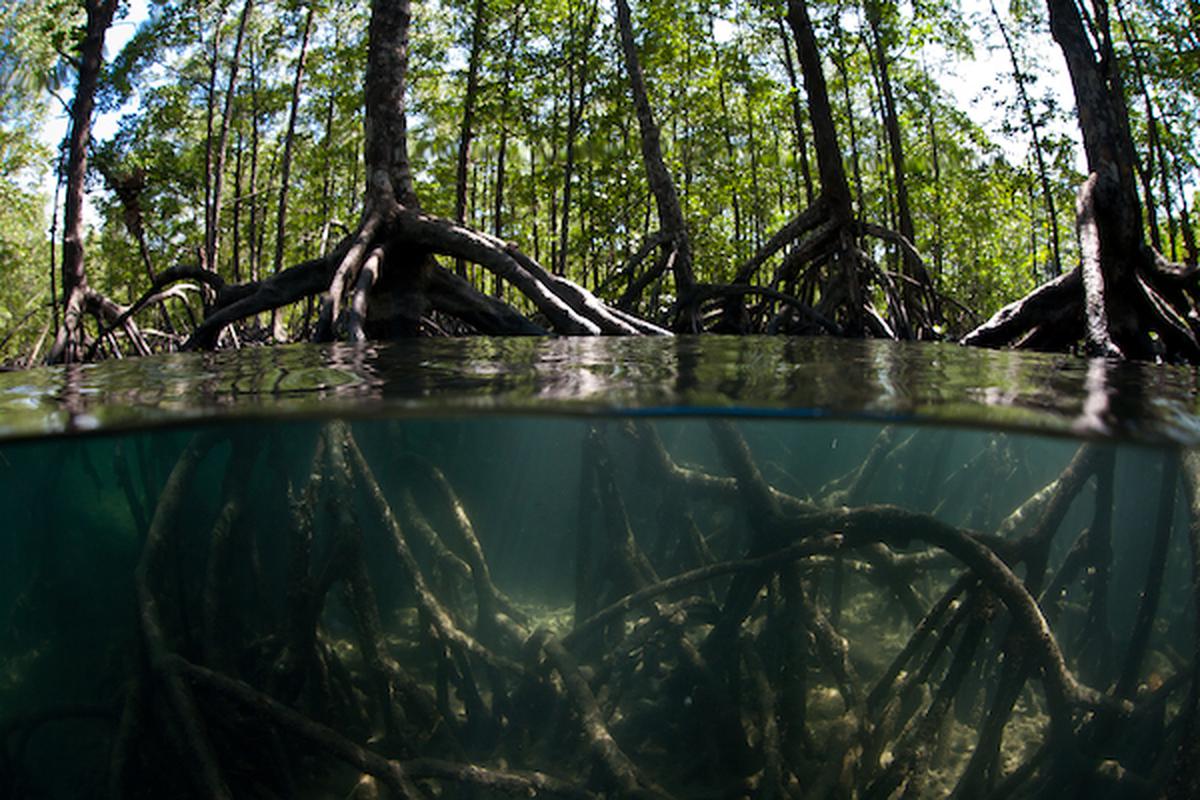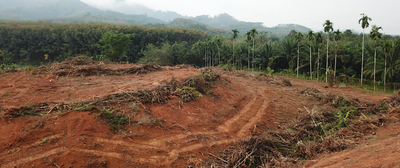
Magical forests: protecting Myanmar's natural climate guardians
Do you know Myanmar is one of the most mangroves-rich countries in the world?
With about 500,000 hectares as of 2019, Myanmar has the second largest area of mangroves and one of the highest mangrove species richness in the Indian Ocean, after Indonesia. Growing throughout the 2,000 km of coastline along the Bay of Bangalstrip, mangroves expand from Rakhine, the Ayeyarwady Delta and Tanintharyi regions. There are 34 out of the global total of around 70 mangrove tree species (1) in Myanmar alone. The largest patches can be found in the Ayeyarwady River delta. However, mangroves are severely threatened by habitat loss in Myanmar.
Mangroves offer a critical environment to marine and terrestrial species. They can be a nursing environment for juveniles of many marine species, such as the saltwater crocodile (Crocodylus porosus) and the critically endangered four-toed terrapin (Batagur baska), and nesting and resting places for many water bird species, including the oriental darter (Anhinga melanogaster), little cormorant (Microcarbo niger), reef heron (Egretta gularis) and dusky grey heron (Ardea cinerea). The significance of mangroves goes beyond their ecological functions. For people living in coastal areas, like in the Delta, they are not just mere plants. Mangroves provide valuable ecosystem services which includes crucial coastal protection from natural disaster such as storms, flooding, inundations or tsunamis, serving as a bioshield, erosion control, sediment trapping, and safeguarding the food security of the local communities through nutrient recycling (2). They serve as natural guardians to local people's livelihoods and homes.
Myanmar’s mangroves can also help reduce huge amounts of greenhouse gases from the atmosphere making them a critical resource for climate change mitigation. The loss of mangrove forest in Myanmar negatively impacts the human well-being, development factors of the country and the habitat available for mangrove-dependent wildlife.
Where are Myanmar’s mangrove forests?
Mangrove ecosystems can be found in three areas: Rakhine state, Ayeyarwady floodplains and Tanintharyi coastline.
- Delta Mangroves
The delta mangroves can be found in Ayeyarwady Delta (also known as Irrawaddy Delta) which spans over 35,000 km2 (13,500 mi2). The Ayeyarwady delta is one of the major tropical deltas in the world. Home to 29 confirmed species of mangrove trees, making it the most complex mangrove system in Asia (4). But the region is experiencing the rapid loss of mangrove forest reaching 70% loss in recent decades (3). Major causes of Mangrove degradation include clearing and conversion to rice paddy cultivation, aquaculture and harvest of timber and fuel wood. The local population is highly dependent on the mangrove ecosystem for various needs including fuelwood and fisheries.
- Rakhine mangroves
The Rakhine mangroves occupy the intertidal zone of the Rakhine coastline. Here, mangroves occur on softs and muddy ground. As a result of tidal incursion, they have a very high-water salinity. There are at least 28 species, including some critically endangered such as Bruguiera hainesii and Sonneratia griffithii. In Rakhine, extensive mangrove degradation has been caused by construction of artificial sea walls and illegal wood cutting, brick backing and bark peeling (4). According to an assessment of time-series vegetation indices, 12% degradation of the ecosystem since 2020 are found, and 40% of the ecosystem is expected to be degraded by 2050 (5).
- Mature mangroves in Tanintharyi region
The large areas of mature mangroves can be found in Tanintharyi region which is in the southern part of the country. Mangroves forests in the Myeik coastal zone inhabit along the deltaic areas of the Tanintharyi River. However, those forests are undergoing large-scale degradation due to natural disturbances and anthropogenic activities (6). The main causes of deforestation include the expansion of agricultural activities such as palm oil cultivation, aquaculture, and rice production. However, the extent of their decline has not yet reached the thresholds that would classify them as experiencing a significant reduction in their geographic distribution (7).

Why are mangrove forests important?
With natural infrastructure, Mangroves protect the nearby populated areas from storm surge and extreme weather. They serve as a lifeline for local communities, especially landless laborers, who rely on them for sustenance and income. These communities depend on mangrove forests for various resources. The significance of mangroves in supporting rural livelihoods, both directly and indirectly for subsistence and commercial purposes, underscores the importance of quantifying their contribution. 43% to total household income generated by selling forest products collected from the mangrove forest such as firewoods, fishes, crabs and prawn (6).
This quantification is crucial for the conservation of the mangrove area and the well-being of the communities dependent on it.
Because Mangrove Forests
- Stores carbon and help in regulating the climate
- Protect extreme weather events
- Provides the communities with food, fuel, timber, and medicine
- Stabilise & protect the coastline
- Improve & maintain local water quality
- Reduce coastal flooding and erosion
- Provide habitats
- Serves as biodiversity hotspots
- Contribute income for local communities.
What is driving mangrove forests degradation and deforestation?
Although mangrove forests are valuable to the living things, they have been drastically degraded and denuded by various factors driven by human activities with socio-economic purposes.
Mangrove degradation and deforestation has dealt a heavy blow to both coastal livelihoods and biodiversity. Land clearing and conversion to rice paddy cultivation, palm oil monoculture expansion and development of unsustainable aquaculture of fish and shrimp ponds are the main causes of degradation of mangroves in Myanmar (6). Along the coastal areas of Rakhine and the Ayeryawaddy delta the impact of frequent storms and the Cyclone Nargis, which hit the region in 2008, have also contributed (although less severely) to mangrove ecosystem disruption. According to National University of Singapore, more than 60 per cent of all mangroves in Myanmar had been permanently or temporarily converted to other uses over the 20-year period (12).
Another major cause includes the harvest of timber and fuel wood and charcoal production, and the land use for settlement, salt fields, shrimp farms etc (7). As a consequence of these various factors, mangrove deforestation is recognized as a critical environmental issue in the country.
Mangrove charcoal also known locally as “de yay taw mee thway” is widely demanded by local communities because of its quality which includes higher energy efficiency, long lasting effect, as well as its hard and dense characteristic. Mangrove charcoal is made from hardwood mangrove trees.
With the rapid exploitation of mangrove forests for charcoal production and overuse of the forests for agricultural purposes, the mangrove forests are encountering a wide range of threats.
The small-scale charcoal production in Chaung Tha and Shwe Thaung Yan of Ayeyarwaddy region has ceased in conjunction with the shortage of mangrove forests. Between 1971 and 1993, the Ayeyarwady Delta alone supplied 85% of the charcoal consumed in Yangon (JICA, 2005).
Presently, charcoal production mainly occurs in Katha and Myeik, which of substantial amounts are regularly exported to China and Thailand. Bago is also reported having a significant market share in charcoal production. As a result, Myeik has become the primary location for mangrove charcoal production due to the remaining abundance of mangrove forests. However, mangrove deforestation continues to be driven by other factors, such as excessive wood extraction and the rapid expansion of the agriculture and aquaculture sectors.

How can the mangrove forests be preserved?
Conserving Mangroves is a critical part of making strides towards a sustainable ecosystem. Cultivating mangrove-friendly aquaculture is one of the effective ways to avoid deforestation and inefficient utilisation of forest resources.
Mangrove-friendly aquaculture presents a promising approach to enhance both ecosystems and local livelihoods while preserving the existing mangrove forests.
Mud-crab farming which can be executed in the Ayeyarwady Delta (potential area for MFA in Ayeyarwady - more than 130,000 hectares) exemplifies mangrove-friendliness. It relatively requires small and shallow ponds. Letting the mangroves thrive in good condition within the ponds directly contributes to the health and productivity of the crabs as they generate crucial microhabitats for the crabs' development. Moreover, the combination of growing mangrove and aquaculture unleash the substantial long-term economic benefits from aquaculture, with an estimated increase of up to 40%. In addition to economic benefit, Mangrove Friendly Aquaculture has potential for carbon sequestration of up to 3,340,416 MtCO2e in the next 20 years contribution to global climate change mitigation.
By striking a balance between sustainable aquaculture practices and the preservation of mangrove ecosystems, the positive outcomes for both the environment and local communities can be fostered. The power of communities can be applied in gathering real-time data on mangroves. Having accurate and frequent data can help to track progress, prioritize action and communicate the value of Myanmar's ecosystems. Through raising awareness about the importance of mangrove ecosystems among the communities and leveraging them to monitor mangroves in their respective areas, mangrove restoration can be enhanced and sustainable conservation of mangroves can be achieved.

References
1. Contribution of Mangrove Forest to the Livelihood of Local Communities in Ayeyarwaddy Region, Myanmar. Wai Nyein Aye, Yali Wen, Kim Marin, Shivaraj Thapa, Aung W. Tun. 2019, Forests, p. 1.
2. Bijeesh Kozhikkodan Veettil, Sebastian Felipe Ruiz Pereira, Ngo Xuan Quang. Rapidly diminishing mangrove forests in Myanmar (Burma): a review. s.l. : Springer International Publishing AG, 2018. 822:19–35.
3. Bijeesh Kozhikkodan Veettil,Sebastian Felipe Ruiz Pereira, Ngo Xuan Quang. Rapidly diminishing mangrove forests in Myanmar (Burma): a review. s.l. : Springer International Publishing AG,, 2018. 822:19–35.
4. Improved estimates of mangrove cover and change reveal catastrophic deforestation in Myanmar. Jose Don T De Alban, Johanness Jamaludin, Donovan Wong de Wen, Maung Maung Than, Edward L Webb. 3, s.l. : IOP Publishing Ltd, 2020, Vol. 15. Lett. 15 034034.
5. Threatened Ecosystems of Myanmar. Murray, N.J., Keith, D.A., Tizard, R., Duncan, A., Htut, W.T., Hlaing, N., Oo, A.H., Ya, K.Z., Grantham, H. s.l. : Wildlife Conservation Society., 2020, Vol. 1. 978-0-9903852-5-7.
6. Diversity and distribution of true mangroves in Myeik coastal areas, Myanmar. Tin Zar Ni Win, Tin Tin Kyu, U Soe Win. 5, s.l. : Aquaculture & Marine Biology, 2019, Vol. 8.
7. Threatened Ecosystems of Myanmar. Murray, N.J., Keith, D.A., Tizard, R., Duncan, A., Htut, W.T., Hlaing, N., Oo, A.H., Ya, K.Z., Grantham, H. s.l. : Wildlife Conservation Society, 2020, Vol. 1. ISBN: 978-0-9903852-5-7.
8. Japan Wildlife Research Center (JWRC), Kaoru Ichikawa (UNU-IAS), ed. Myanmar: Mangrove Forests in the Ayeyarwady Delta. Satoyama Initiative. [Online] March 6, 2012. [Cited: March 6, 2012.] https://satoyama-initiative.org/case_studies/myanmar-mangrove-forests-in-the-ayeyarwady-delta/.
9. Sang Phan, Aaron Russell, Juan Jose Robalino, Ali Akber, Ammar Aziz, Catherine Lovelock. Economic Appraisal of Ayeyarwady Delta Mangrove Forests. s.l. : The GGKP Secretariat, 2020. GGKP (2020)..
10. Contribution of Mangrove Forest to the Livelihood of Local Communities in Ayeyarwaddy Region, Myanmar. Wai Nyein Aye, Yali Wen, Kim Marin, Shivaraj Thapa, Aung W. Tun. 414, s.l. : Forests, 2019, Vol. 10. f10050414.
11. Sang Phan, Aaron Russell, Juan Jose Robalino, Ali Akber, Ammar Aziz, Catherine Lovelock. Economic Appraisal of Ayeyarwady Delta Mangrove Forests. s.l. : The Green Growth Knowledge Partnership (GGKP), 2020. GGKP (2020).
12. NUS. Research Impact. NUS News. [Online] National University of Singapore , March 3, 2020. https://news.nus.edu.sg/over-60-per-cent-of-myanmars-mangroves-deforested-in-the-last-20-years/.
13. Than, Maung Maung. Environment Sector Review and Formulation of Reforestation Strategy for the Ayeyarwady Delta. s.l. : UNDP, 2009. MYA/01/001.



